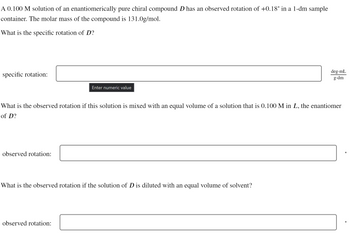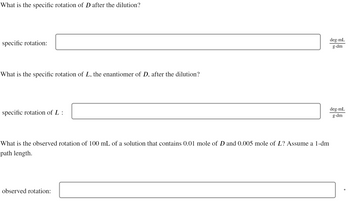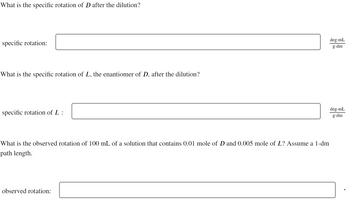A 0.100 M solution of an enantiomerically pure chiral compound D has an observed rotation of +0.18° in a 1-dm sample container. The molar mass of the compound is 131.0g/mol. What is the specific rotation of D? specific rotation: observed rotation: Enter numeric value What is the observed rotation if this solution is mixed with an equal volume of a solution that is 0.100 M in L, the enantiomer of D? What is the observed rotation if the solution of D is diluted with an equal volume of solvent? observed rotation: deg-mL g.dm
A 0.100 M solution of an enantiomerically pure chiral compound D has an observed rotation of +0.18° in a 1-dm sample container. The molar mass of the compound is 131.0g/mol. What is the specific rotation of D? specific rotation: observed rotation: Enter numeric value What is the observed rotation if this solution is mixed with an equal volume of a solution that is 0.100 M in L, the enantiomer of D? What is the observed rotation if the solution of D is diluted with an equal volume of solvent? observed rotation: deg-mL g.dm
Chemistry
10th Edition
ISBN:9781305957404
Author:Steven S. Zumdahl, Susan A. Zumdahl, Donald J. DeCoste
Publisher:Steven S. Zumdahl, Susan A. Zumdahl, Donald J. DeCoste
Chapter1: Chemical Foundations
Section: Chapter Questions
Problem 1RQ: Define and explain the differences between the following terms. a. law and theory b. theory and...
Related questions
Question

Transcribed Image Text:A 0.100 M solution of an enantiomerically pure chiral compound D has an observed rotation of +0.18° in a 1-dm sample
container. The molar mass of the compound is 131.0g/mol.
What is the specific rotation of D?
specific rotation:
observed rotation:
Enter numeric value
What is the observed rotation if this solution is mixed with an equal volume of a solution that is 0.100 M in L, the enantiomer
of D?
What is the observed rotation if the solution of D is diluted with an equal volume of solvent?
observed rotation:
deg.mL
g.dm
O

Transcribed Image Text:What is the specific rotation of D after the dilution?
specific rotation:
What is the specific rotation of L, the enantiomer of D, after the dilution?
specific rotation of L :
What is the observed rotation of 100 mL of a solution that contains 0.01 mole of D and 0.005 mole of L? Assume a 1-dm
path length.
observed rotation:
deg.mL
g.dm
deg.mL
g.dm
O
Expert Solution
This question has been solved!
Explore an expertly crafted, step-by-step solution for a thorough understanding of key concepts.
This is a popular solution!
Trending now
This is a popular solution!
Step by step
Solved in 2 steps

Follow-up Questions
Read through expert solutions to related follow-up questions below.
Follow-up Question
Answers for the last three

Transcribed Image Text:A 0.100 M solution of an enantiomerically pure chiral compound D has an observed rotation of +0.18° in a 1-dm sample
container. The molar mass of the compound is 131.0g/mol.
What is the specific rotation of D?
specific rotation:
observed rotation:
Enter numeric value
What is the observed rotation if this solution is mixed with an equal volume of a solution that is 0.100 M in L, the enantiomer
of D?
What is the observed rotation if the solution of D is diluted with an equal volume of solvent?
observed rotation:
deg.mL
g.dm
O

Transcribed Image Text:What is the specific rotation of D after the dilution?
specific rotation:
What is the specific rotation of L, the enantiomer of D, after the dilution?
specific rotation of L :
What is the observed rotation of 100 mL of a solution that contains 0.01 mole of D and 0.005 mole of L? Assume a 1-dm
path length.
observed rotation:
deg.mL
g.dm
deg.mL
g.dm
O
Solution
Follow-up Question
what are the answers for the last three

Transcribed Image Text:What is the specific rotation of D after the dilution?
specific rotation:
What is the specific rotation of L, the enantiomer of D, after the dilution?
specific rotation of L :
What is the observed rotation of 100 mL of a solution that contains 0.01 mole of D and 0.005 mole of L? Assume a 1-dm
path length.
observed rotation:
deg.mL
g.dm
deg.mL
g.dm
O
Solution
Knowledge Booster
Learn more about
Need a deep-dive on the concept behind this application? Look no further. Learn more about this topic, chemistry and related others by exploring similar questions and additional content below.Recommended textbooks for you

Chemistry
Chemistry
ISBN:
9781305957404
Author:
Steven S. Zumdahl, Susan A. Zumdahl, Donald J. DeCoste
Publisher:
Cengage Learning

Chemistry
Chemistry
ISBN:
9781259911156
Author:
Raymond Chang Dr., Jason Overby Professor
Publisher:
McGraw-Hill Education

Principles of Instrumental Analysis
Chemistry
ISBN:
9781305577213
Author:
Douglas A. Skoog, F. James Holler, Stanley R. Crouch
Publisher:
Cengage Learning

Chemistry
Chemistry
ISBN:
9781305957404
Author:
Steven S. Zumdahl, Susan A. Zumdahl, Donald J. DeCoste
Publisher:
Cengage Learning

Chemistry
Chemistry
ISBN:
9781259911156
Author:
Raymond Chang Dr., Jason Overby Professor
Publisher:
McGraw-Hill Education

Principles of Instrumental Analysis
Chemistry
ISBN:
9781305577213
Author:
Douglas A. Skoog, F. James Holler, Stanley R. Crouch
Publisher:
Cengage Learning

Organic Chemistry
Chemistry
ISBN:
9780078021558
Author:
Janice Gorzynski Smith Dr.
Publisher:
McGraw-Hill Education

Chemistry: Principles and Reactions
Chemistry
ISBN:
9781305079373
Author:
William L. Masterton, Cecile N. Hurley
Publisher:
Cengage Learning

Elementary Principles of Chemical Processes, Bind…
Chemistry
ISBN:
9781118431221
Author:
Richard M. Felder, Ronald W. Rousseau, Lisa G. Bullard
Publisher:
WILEY